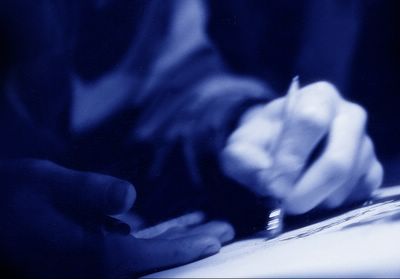 Some sad news courtesy of Tim Lucas’ daily Video WatchBlog (for those of us who can’t stand the interminable weeks between issues of his always-essential Video Watchdog magazine) and David Hudson's GreenCine Daily: Freddie Francis, the great director-of-photography (or, as they say in the UK film industry: “lighting cameramen”) on many beloved classics—mainstream and cult—and a fine director as well, has passed away on March 17 at the age of 89. It’s hard for me to single out a “best” anything—movie, novel, album, actor, etc.—but if I had to pick a “Best DOP Of All Time”, Francis would probably be at the top of the list based on his work for David Lynch alone.
Some sad news courtesy of Tim Lucas’ daily Video WatchBlog (for those of us who can’t stand the interminable weeks between issues of his always-essential Video Watchdog magazine) and David Hudson's GreenCine Daily: Freddie Francis, the great director-of-photography (or, as they say in the UK film industry: “lighting cameramen”) on many beloved classics—mainstream and cult—and a fine director as well, has passed away on March 17 at the age of 89. It’s hard for me to single out a “best” anything—movie, novel, album, actor, etc.—but if I had to pick a “Best DOP Of All Time”, Francis would probably be at the top of the list based on his work for David Lynch alone.Francis was born in Islington in 1917, and began his career as a still photographer on shoots before apprenticing as a cinematographer. His first solo credit as DOP was 1956’s “A Hill In Korea”. He’d go on to lens many of the more celebrated on British dramas of the 50s and 60s, including “Room At The Top” and “Sons And Lovers” (for which he won his first Academy Award). He also shot John Huston’s adaptation of “Moby Dick”, but his most celebrated effort—deservedly—remains Jack Clayton’s “The Innocents”, adapted by Truman Capote from Henry James’ “Turn Of The Screw”, which is not only one of the most gorgeously-photographed films ever made (right up there with “Citizen Kane” IMHO), but that rare film that can terrify with scenes set and shot in broad daylight.
Francis directed his first feature, “Two And Two Make Six” in 1961, and codirected the loose adaptation of “Day Of The Triffids” in 1963 and soon began helming thrillers for Hammer Studios and Milton Subotsky’s Amicus Productions, the superb “Paranoiac” (1963), with Oliver Reed, and “The Psychopath” (1966), written by Robert Bloch, to name but two (there’s also “The Ghoul”, “Legend OF The Werwwolf”, “The Creeping Flesh”, all worth checking out).
Francis’ horror features would never be held in the same regard as those of Terence Fisher, John Gilling, or Roy Ward Baker, but the best of them were stylish and unique, often fearlessly eschewing the formulas of the respective “Dracula” and “Frankenstein” series that by the time Francis directed his installments were showing signs of fatigue (and on both productions, Francis was hired to step in for Fisher at the last minute). “The Evil Of Frankenstein” (1964) and “Dracula Has Risen From The Grave” (1968) have continued to polarize enthusiasts since their releases but endure as stylish exercises enriched by Francis’ eye and unique, if not particularly passionate, voice (to the surprise of most of his fans, he wasn’t much of a horror buff). I first saw “DHRFTG” on a double bill when I was about 9 years old—yes, Hammer Films served as “kiddie matinee” programmers in my hometown—and have never forgotten the great poster art featuring a buxom gal sporting two band-aids on her neck.
Francis' name became emblazoned on my movie-mad cranium with an early-80s re-release of the 1972 Amicus anthology “Tales From The Crypt”, in which a cast and crew of Brits tackled William Gaines’ oh-so-American grue-filled morality tales that caused Frederick Wertham to go ballistic (it’s the one everyone remembers for the opening tale in which Joan Collins is stalked by the killer Santa, but the best story is really “Poetic Justice”, starring Kubrick-vet Patrick Magee). Before that, Francis directed Amicus’ omnibus “Dr. Terror’s House Of Horrors” (1965), hosted by Hammer vet Peter Cushing in the title role. He’d helm two more anthologies: “Torture Garden” (1967) and “Tales That Witness Madness” (1973). He paired up an aging Joan Crawford with an unconvincing caveman in the silly “Trog” (1970), and Ringo Starr with Harry Nilsson in 1974’s “Son Of Dracula”. He’d just direct one more feature film, 1985’s “The Doctor And The Devils”, the story of Burke and Hare, starring Jonathon Pryce and Timothy Dalton, adapted from an unfilmed screenplay by Dylan Thomas.
Throughout the 80s and 90s, Francis devoted himself to cinematography and proved his versatility on everything from “The French Lieutenant’s Woman” (1981) to the Tom Selleck comedy “Her Alibi” (1989) to Scorcese's "Cape Fear" remake to Ed Zwick’s Civil War drama “Glory” (1989) for which he was awarded his second Oscar.
But it was his work for David Lynch that, for me, defines his contribution to the art: think of the period authenticity of “The Elephant Man” (1980), the collision of futuristic and retro styles in the unfairly-maligned “Dune” (1985), and of course, the celebration of the sprawling American landscape and the small dramas that play out within it in “The Straight Story” (1999).
Francis returned to the director's chair just once more time, in 1996, for “Last Respects”, an episode of the HBO revival of “Tales From The Crypt”, which he’d already adapted in the Amicus feature version (which I’m embarrassed to admit I’ve somehow missed).
To anyone in the creative fields, Francis’ legacy and longevity are enviable and inspiring. Read The Telegraph's comprehensive obit here.
(I must acknowledge my huge debt to John McCarty’s “The Fearmakers”, Marcus Hearn and Alan Barnes’ “The Hammer Story”, and Tim Lucas’ “VideoWatchblog”)
-Robert L



